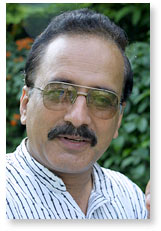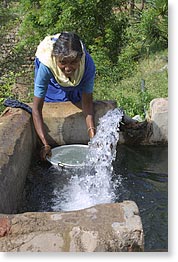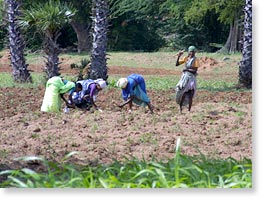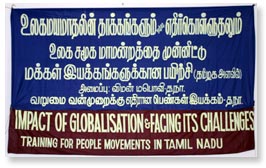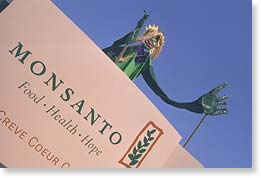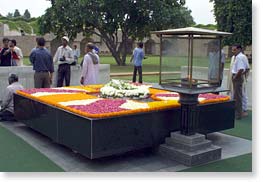|
Interview with Devinder Sharma The politics of food and agriculture Part 2 From secured-cash crops to village republics New Delhi, India
Devinder Sharma is an award-winning journalist, writer, and researcher on food and trade policy. He is the author of "GATT and India -- Politics of Agriculture" (1994) and "In the Famine Trap" (1997). He chairs the New Delhi-based Forum for Biotechnology & Food Security.This interview was conducted August 25, 2003 by Nic Paget-Clarke for In Motion Magazine in New Delhi, India.
Devinder Sharma: There is no denying that these four sectors are very important. But if you look at it the way we are being told to, we should not follow our own traditionally applicable and time-tested technologies and methodologies, which are suitable to the country’s needs and to the environment. Let’s look at water. We have in India a watershed program which talks about conserving water. In India, the rainwater comes in a hundred hours, in the three months of the monsoon season, that is where we get 90% of our rainfall. In America, it’s intermittent throughout the year. For us, it is very important to conserve that rainwater, so we are saying that we should follow water harvesting technologies. But the tragedy is the water harvesting methodologies we follow in India are actually borrowed from America. The Tennessee Valley Authority in America has a water harvesting structure, which is called “ridge to valley”. That model was adopted by India. Since 1982, we have been propagating this water-harvesting model, supported by the World Bank and IMF and it has spread throughout the country. But the tragedy is that model is alien technology for India. It can never work for an Indian environment because it is not suitable for India. It was suitable for American conditions. And look at the irony, today the American Texas A&M University is using the water harvesting model of Chennai (south-eastern India) in their own research farms whereas we are using the American technology. So, unfortunately, we have no faith in our technologies. When I was taught agriculture, all that I was taught was that, “Your agriculture is substandard. Your agriculture is backward. Your agriculture is dependent on monsoon. The only way for you to grow is to follow the American or developed model of agriculture.” So, the mindset has been tuned to that. For us, all that we did in Indian agriculture was backward. But these (developed) technologies have caused lots of problems as we all know, now. Number two is the system of agriculture technology. We are being told that the world needs to produce for a world population that will go up to 1.4 billion by year 2015. Therefore, the world needs to produce more and therefore you need genetic engineering. This is going on all over the world. But the reality is in a country like India, we are asking our farmers not to produce more because they have no place to keep it. In India, there is a new phenomenon, which has begun called “produce and perish”. Farmers produce and because there are no buyers they perish. They commit suicide. And we are being told we have to produce more. There is something wrong somewhere. Both things don’t go side by side. So, agriculture technology, again it has to come from the Western companies, the Western NGOs. Self-help groups, the women groups are something which came up from Grameen Bank, and so on, and we have taken that thing (micro-credit) and multiplied it without even realizing whether it was good or bad. I see no reason why the poor should get a loan, a credit from the bank at 24%, which the Grameen Bank provides. I see no reason why the corporate houses in India should get a credit at 6% rate of interest. The more they are poor, the higher the rate of interest. There was a debate in parliament, two days back, and in that debate one of our ex-Prime Ministers was very emotionally talking about the farmers getting credit at 14%, whereas the rich or middle class is getting the credit at 6 to 8 %. I told him subsequently that you are worried about 14%, which the farmers are getting, which of course is bad, but look at the tribals in the Kalahandi belt. Nobody can imagine that those poor who are hungry, who die of starvation and hunger, when they go to the money-lenders to take credit, the rate of interest is 460%. I’m sure even if Monsanto was to pay a rate of interest of 460% the company would collapse. And we expect those poor to come out of the poverty trap? All our focus is to ensure that the rich get the credit much cheaper, and then we believe in the trickle-down effect. It is the poor who are being taxed, who are being exploited in all these games. If you are able to pass on that benefit to the poor, I’m sure the poor can do miracles. But that is not happening
There are traditional farming systems in India that nobody wants to take on because they think that they are backward. Essentially, the word is they are backward and they are substandard. But if you look at it, 70% of India is still following traditional farming practices. They are the ones who are farming in inhospitable areas. Only 30 percent of India is what is called assured-irrigation. That is the Green Revolution belt. So 70% of India is still following traditional farming practices. Their focus should be to improve those traditional farming practices rather than to displace those farmers or those systems by the modern technology, the so-called high-tech technology. Let me give another comparison here, America is considered to be a place which has very sophisticated technology. 2002 was a year when America faced the worst drought since the 1930s. 2002 was also a year when India faced the worst drought since the nineteenth century. Both the countries faced a severe drought. It is time to compare these countries. If you look at America, 26 of your 50 states suffered from drought. In India, 13 of the 30 states suffered from drought. In America, the agriculture production fell down by 30%. In India it fell down by 18%. I remember going to America and finding that there were farmers praying in churches in rural areas, praying for the rain gods to smile. There were farmers who sold off their ranches. Farmers who sold off their cattle. There was a terrible shortfall of fodder. President Bush diverted $150 million of milk to feed the cattle. The so-called precision farming in America collapsed. We talk of precision farming in America, you apply fertilizer and pesticides where it is needed, your rainfall is intermittent throughout the year so there should be no problem of water. You have sprinklers, drip irrigation and so forth. But look at what happened. North Carolina was fighting with South Carolina over water. In a number of states, irrigation of kitchen gardens and washing cars was banned. It didn’t happen in India. Which means that technology is not the one which we should adopt in India. Despite the cost and sophistication, it didn’t work in America. With one drought it failed. So why do we adopt the same system here? We are sitting right now in Delhi, if you go to the India Agriculture Research Institute they are going to launch a research project for precision farming. They are going to spend three crore rupees, which means 30 million rupees to do a research project on precision farming because the Americans are doing it. Is that that the requirement for India? In Motion Magazine: Are there examples of local organizing where people are getting involved in trying to bring about changes in India using these techniques? Devinder Sharma: Not only in India. If you look around the developing countries, there are many, many such examples which of course the scientists don’t want to accept. In a place in Bihar, now it has also gone into a state called Jharkand, there is a group of villages, 50-odd villages which have been part of what is called a “Chakriya Vikas Pranali” which means Cyclic Mode of Development. It was started by an amazing person from the same area. It has gone into what is called a “three is to three to three to one system” of sharing the produce and the income from that piece of land. This is with the landless – the work on the land in that area. What I want to say is, in those areas, they look like an oasis in the entire hunger belt of Jharkand, near Bihar. These 50 villages are the areas which look prosperous compared to that area. In an area where rupees-ten is a big income for a day, these are the villages where they have village’s funds of about 100,000 rupees each, that would be only ten percent of what they have earned. And they have done it completely by their own traditional ways.
You go around in various parts of the country and you will find these kinds of examples. But they are spread all over the country. Nobody wants to bring them together and draw a lesson from them. That is a tragedy because multinational companies come, they have their PR (public relations) units behind them, and they keep on bombarding us with this information that, “You have no other escape but to use this kind of technology.” And, “We will do wonders for economic growth” and so on. We are lured by that. But go to see these examples, There are thousands and thousands of examples. Jules Pretty, in one of his publications, has documented many of them. Jules Pretty is a professor at one of the universities in UK. He has written on sustainable farming practices -- where the people have done it. In Motion Magazine: Do you think there is a beginning of a real democratic movement that is coming out of these kinds of organizing efforts, and in contradiction to globalization? Devinder Sharma: Yes, and what the government says is something different. You will see the numbers are multiplying. The interesting part is when we started looking at all these things we first thought that they are happening but they will disappear because of the onslaught of the technology-based companies and so on. But, surprisingly, it hasn’t happened. These numbers are multiplying. More and more people are going back to these traditional systems and that’s a great ray of hope for the kind of things we are talking about – sustainable farming, sustainable agriculture, a sustainable future. Just to give an example, Punjab is the food bowl of India. Punjab is an area which is ecologically diverse today. 60 percent of the country’s food surplus comes from Punjab, the northwest part of India. But that’s the area where we have reached a second generation bottle-neck as far as environmental damage done -- the water table going down drastically, soil becoming in a pathetically bad situation. The soil is hungry. The ecology has gone bad. The capacity to produce of the soil has gone down drastically, and so on. But now the farmers are reverting back. Many farmers in that state are reverting back to traditional farming practices. They realize that all these experiments they did in the Green Revolution period have done damage. People are trying to go back. It may be a small experiment but I always believe as Neil Armstrong said, when he stepped on the moon, “A small step for man, a giant leap for mankind.” As Hillary Clinton also said once, “It takes a village,” then another village, then another village - the multiplier effect- and a revolution is born. I am very hopeful about that.
Devinder Sharma: In the villages? Yes, but not at the national scene. In Motion Magazine: It’s growing? Devinder Sharma: Slowly. In Motion Magazine: From active involvement by people? Devinder Sharma: I will give you one example. India has about 600,000 villages. And we know the condition of the villages. But, can you believe, roughly 1,500-plus of India’s villages have actually put signboards outside their village saying, “If you are a government employee, or a company official, please don’t walk in.” And it hasn’t happened as a movement. It has happened sporadically. They are all spread over the country, these 1,500 villages. These are the villages, which have become complete, what I call, as village republics. They are self-sufficient. They don’t need anybody’s support. And 1500, my God, is not a small number. If that 1,500 multiplies to 3,000 in the years to come, just see what will happen to this country. We don’t need external support. What all those villages are saying is, “Please don’t come up with these external supports to use. We have had enough.” “Engineer bureaucrat and contractor friendly” In Motion Magazine: In the implementation of some of these efforts for sustainable development, you have talked about them disparagingly as “engineer bureaucrat and contractor friendly”. What is a better way of developing sustainable agriculture? Devinder Sharma: It has to be based on the local needs, the local environment, the local capacity of the farmers, and local technology. And that is what has been amply demonstrated. Just to give an example, if you look at WTO negotiations, every time Frank Fischler, the European Union Agriculture Commissioner, talks about the kinds of things that he is doing under WTO, “The developing country farmer will gain.” But the tragedy has been that when, two years back, Frank Fischler came to India that was the first time he had ever visited a developing country. He has always been talking about the benefits to developing countries, yet even when he came to India he did not meet farmers. He doesn’t even know what the farmers of India look like. Sitting there in Brussels, or in Geneva, or in Washington we tend to believe, “This is wonderful. What we are doing will help the farmers.” I think that is the greatest tragedy, because we are basically uneducated and if we go to these farmers we can learn from them. They carry with them hundreds or thousands of years of experience. I think the world should go backwards and learn from them rather than think that they are backward and poor so they need to be taught. That was the biggest tragedy of the Green Revolution model. The Green Revolution Model talked about “lab to land”, it didn’t talk of “land to land”, and that is why you find all these problems coming up all over the world wherever Green Revolution is followed. When I was a student of the Green Revolution model, I was taught the land grant model of education, and it tended to believe, “We need to disseminate this information to the farmers.” It takes farmers as a bloc of unread illiterates who don’t know about all these things. “They have to be educated.” Whereas, these people have tremendous wisdom with them. That was what the Green Revolution should have got back. But they didn’t and look where the world is heading. In a country like ours, which is a land of contrasts -- India is truly a subcontinent, as we all know -- you can find all kinds of experiments, which could have been done. You could have answers to all kind of things that you are looking all over the world for. There are sustainable answers with people and we never went back to them. We never want to learn from them. It is shameful if a man with a PhD goes and sits with a farmer and learns something. Leading the world into two clear halves In Motion Magazine: How would you compare the state of liberalization at the time you wrote the book, in 1992, and now? Devinder Sharma: When I came out with my book on agriculture and WTO / GATT, it was dubbed as an analysis which was extreme, not true for India, “India is going to gain” and so on and forth. In fact, the Indian Finance Minister subsequently said, “That book has been written by somebody who never read the GATT Agreement.” There were lots of comments about me. In the subsequent title of this book, the next edition, it was called, “GATT/WTO Seeds of Despair”. I was very clear that there’s going to be a negative thing for us. Interestingly, the government of India, two years back, published a document which was released in Delhi in a forum to which it invited farmer leaders, political leaders and the NGOs. The document says, it was evaluating the WTO Agreement on Agriculture, that all the hopes and expectations from opening up under WTO have been belied. The government of India took seven or eight years to realize that this was negatively impacting us. I think anyone who had a keen insight into the political economy, the way the world was moving, could see where it was moving. I’m glad now the book is being dug out. Lots of people are taking it out and trying to see what was said there. It is now coming out to be true. In fact, all that I have said is now coming out to be true. It is nothing to be complimenting oneself, the only thing I am trying to say is if you are dispassionately trying to analyze the realities, knowing the political situation going on, you can see where the world is moving. The liberalization process is leading the world into two clear halves, whether it is through WTO or through the financial institutions of World Bank and IMF. It is now forcing the world to move on to a stage where the staple foods will be produced by the OECD countries. The rest of the world will mainly produce products or crops which will meet the luxury requirements of people in the Western countries. From staple foods to cash crops In Motion Magazine: Like what?
Now, why is it happening? Why I am saying this is based on analysis, based on an understanding. Today, Europe exports about 18% of the world’s agriculture, the European Union. 17% is contributed by America. Add on the Cairns Group (editor: group of 17 agricultural exporting countries, formed in 1986) as such, as a bloc, they will take another 20%. Which means about 50, 55% is in the hands of these three blocs – which are essentially the OECD blocs. But, interestingly, through the WTO we are asked to lift up trade barriers, reduce our tariffs, so that the cheaper food can come into our countries. When cheaper food comes the entire focus is on destroying your food self-sufficiency. Once you are not food self sufficient, once you become dependent then you become dependent, for all times to come. Look at the other way. The World Bank and IMF, they tell us in India that, “You produce enough wheat and rice, and so on. You need to diversify.” Diversification of agriculture is the new mantra. Whether it is India, whether it is China, whether it is Pakistan, whether it is Philippines or Africa – we should all diversify. Why? Because we are producing too much of grains. Look at the clever intention of the World Bank and IMF. If there is one place or one bloc that should diversify, it is America and Europe. They go on producing soybean after soybean, corn after corn, wheat after wheat. They need to diversify. Nobody tells America to diversify. Nobody tells European Union to diversify. Why is that only we are being told to diversify? And since it comes with money, it comes with credit, facilities the World Bank provides -- the countries are moving on it. They are following the diversification mantra. Basically, we are moving from staple foods to cash crops. You will agree cash crops don’t feed you. They can give you the money if you export, but they don’t feed you. In a country like ours where 1.47 hectares is the average landholding size, you need staple foods so that the poor man can at least feed his family first. You cannot export them to America and then get the dollars. That is what is called the Kalahandi Syndrome. He who controls food controls the world So what are we doing now? Very clearly, the world is full up of nuclear weapons. There’s a tremendous outrage of wars being fought with precision bombs, so the biggest weapon that a country can have is food. Food is the biggest weapon. As long as America and European Union and a few other blocs control food I don’t think they will have any problem. The future of wars will not be fought through the armed forces, to me the food is the biggest weapon. He who controls food controls the world. In Motion Magazine: Which leads to GMOs What is your opinion to GMOs. Devinder Sharma: The same. This is part of the same paradigm. Genetically-modified (GM) crops (editor: also read interview with Dr. Doreen Stabinksy) – one, of course, you are tinkering, whatever you are doing, and the other part is you are controlling the food chain. That is what the GM companies are going to do now. It is part of the same paradigm of World Bank, IMF, GM companies, and the WTO -- if you look at the same liberalization process. What will happen now is the new products that are coming up are also coming up with stronger intellectual property rights. First of all, we don’t have the technology. The technology is in the hands of the Western companies, so the new crop seeds that come from them would have to be bought by us. We have no escape. And they have already ensured things like Terminator (editor: a genetically-engineered seed which only produces for one generation) which is now no longer a concept, it is a product. We will have terminator and seeds that you can program to insure that production goes up or goes down. Then you have the control – control through research. One way is you force the countries to open up so that you can remove the barriers -- the trade can push the food grains. But another aspect, which is worrisome for the West is there are countries like India and China that still have a very powerful and formative research infrastructure in the public sector. India has the second biggest research infrastructure in the world after China. This is a system which can use its expertise to grow crops and at least meet the food security requirement. So, the best way is to dismantle this system. At an international level there is the CGIAR, the Consultative Group on International Agriculture Research. They are under tremendous attack from the multinational corporations because they find them to be the first obstacle. So they will go. We know that their days are numbered. The next attack is going to be on ICR, the Indian Council for Agricultural Research, which has about 31 agricultural universities and about 81 national institutes. They have about 30,000 agricultural scientists employed. But that system is being destabilized through intellectual property rights. Let me give you one example. Rice is a crop which originates from India along with the Japanese region. It is Indo-Japanese. That is why it is classified in two categories, indica and japonica. But now the rice genome has been mapped. We don’t need the varieties that we’ve got in India. What we need now is the genes. The genes are mapped, cloned, and intellectual property rights control exist – they (patents) have been taken out by companies in the Western part of the world. India was recently requiring one gene of rice to be incorporated into rice. We actually went to Japan to buy their gene. We spent 30 lakh rupees which would mean three million rupees to buy one gene. It didn’t work. Imagine if India was to start buying genes in a country where you can’t even pay the staff salaries today. The research infrastructure goes redundant after a few years. We are fast moving to an arena where the research will be stifled, so the private companies take over. We have the entire seed industry moving into India because there is a huge market here. As I said earlier, we have a 110 million landholdings, 557 million farmers, only 10 percent of our farmers replace seed every year which means only ten percent of the farmers buy seed every year. 90 percent still save seed. So, through terminator and other seeds these companies control, steer the market. The first Terminator crop will be available on the market in the year 2004.
Devinder Sharma: Basically, I am a geneticist. I did my genetics on plant breeding and I too was very fascinated by this science. Over the years lots of people have asked me this question. Why have I changed my opinion about GMOs? I think as you go along you see what is happening. You see the politics. You see the mischief. You see the manipulations being enacted. You realize that this technology is not for the welfare of the farming communities of the developing countries. Therefore, your stand also starts hardening knowing the politics that is prevailing. It is not because of the technology. The technology per se is wonderful and I still have great hopes on that, but the technology has gone into the wrong hands. What do you do with that? The tragedy, as I have written in many of my articles, is that the public sector scientists should stand up and say herbicide tolerant plants (editor: e.g. Monsanto’s Roundup Ready soybeans) is not what we require, and they fail to say so. You will have more and more such kinds of products coming into the country which are not required. They doesn’t boost your productivity. They don’t increase your production. They only insure profit for the company – they are basically profit-securing crops. It is not food security they are talking about it is profit security. Scientists have helped the companies profit security – that is what my worry is. In Motion Magazine: Could you talk some more about the privatization of research, in the context of the privatization of the world? Why is that significant? Devinder Sharma: It is very significant. When we had the land grant university coming up in America, India also adopted the land grant model from. The land grant universities in America. were essentially public sector controlled. I read a report, that said there are 535 plant breeders working on corn in America today. Of which only 30 are n the public sector. The rest are in the private sector. This gives you an idea. When I was a student of agriculture, plant breeding, the Mecca of plant breeding was an institute in England called the Plant Breeding Institute in Cambridge. The Plant Breeding Institute was an institute which was a public sector institute. It was an institute which was getting £6 million from the U.K. government as support, but returning £10 million a year to the government. It was not a loss-making unit. But Margaret Thatcher sold off that institute to Unilever. Unilever sold it off to Monsanto. Today that institute is gone. Imagine when these kinds of privatizations start taking place all over the world. In India, these public sector institutes are at least covered by the democratic norms. At least the government can tell, “Look, you should be working on wheat. This is a disease that has erupted. You should be working on it.” But tomorrow, if it is privately controlled, who can tell that institute to work? In a country like India, where the crops are so diverse, where the landholding size is so small, where the insect and the pest attack is virulent because we are in a tropical world, we need to have public sector controlled research which looks beyond profits. Unfortunately that is going away. We may be the last bastion left. Essentially, all countries in my neighborhood are also giving up. It is privatization of research and that research will not be on these kinds of crops we are talking about. They will be more acting as a service center for the companies in the Western hemisphere. For instance, Monsanto requires some experiments to be done in India, these will become the service centers to do that research. In Motion Magazine: You were talking about how the WTO was encouraging diversification among developing countries, is that similar to the British banning, in India, the local manufacture of cloth? Devinder Sharma: You are very right. That is a legacy which still continues. It is very interesting. Cotton was not a major crop of India before the British found that America cotton was not coming. America stopped supplying cotton for the Manchester industry in Britain. So, they diverted attention to India. Cotton erupted in India and it was shipped directly from here to Britain. I think it makes economic sense to have set up a manufacturing plant in India rather than to ship it all the way to England. But they didn’t want that profit to be shared with the Indians. Of course, we were a colony at that time and no colonial master will do that, but even now it is not being done. If you look at the way the way the WTO is doing things, it is just to ensure that the raw material comes from this part of the world. It goes to that part of the world and then it is “value-added” -- the terminology now being used is “value-added” -- and beautifully packed, and then it comes back to us with much more price, and intellectual property rights, and so on, and so forth. Let me give you an example. There are three countries which would top the production chart for tea in the world. That is India, Sri Lanka, and Kenya. They are the three countries which are the major producers of tea. But I’m sure if I were to ask you a question, “Which are the major exporters of tea, you will have an answer.” In Motion Magazine: I would think it was India. Devinder Sharma: That is what everybody would think. The biggest exporters of tea are Luxembourg, Belgium and Britain. They don’t grow tea. In Motion Magazine: So how do they get it there? Devinder Sharma: That is what is very interesting. Because they value add then pack it their value goes up. They become a big exporter of tea than us. We export the raw material. They pack it. They value add it – you can find hundreds of kinds of tea now if you go to the tea shops anywhere in the West, mango tea, lychee tea, all the flavors – they add those values and they ultimately market it. If you look at oranges, we export orange skin to Holland and Holland makes something and exports it to the rest of the world. They are the kind of valuations that are going on. Interestingly the second biggest exporter of agriculture products in the world is Holland. And Holland is not even of the size of Punjab. That is the way the world is moving. To us that is a cause for worry because in our country we are not worried about exports we are worried about our food security needs – feeding the poor. Everything is now being looked at by way of how much you can export. It is agribusiness. Part of our culture, part of their business In India it is agriculture. If you go to Punjab, they say the only culture of Punjab is agriculture. That is what we were actually using agriculture as. It is part of our culture. Whereas, for the West it is part of their business, it is industry, for us, it is part of our livelihood, part of our life. That is the difference and that is why I suppose there is a clash. If you look at rice, for instance, rice doesn’t mean anything to an average American except for what he gets in the market or what he eats. But in India rice has tremendous cultural, religious roles. I get married and the rice is in every kind of ceremony that I involve – rice is there. It is part of our culture, upbringing. And now we are being asked to diverse from that. Under modern systems – this is all backwards.
Devinder Sharma: That’s right. It is basically divide and rule. I think the British were very smart. But there is a ray of hope here, again with the British system. And I have always being saying that. The British empire was a very ruthless empire. As we said earlier, the sun would never set on the British empire. But, one man took up the courage, and there was no media like today, one man took up the courage and the empire crumbled. In Motion Magazine: Can you talk a little about his philosophy (Mohandas K. Gandhi) and how that applies today? Devinder Sharma: I am very hopeful. Lots of people have asked me, the multinationals are a very big force. I said they are not bigger than the British empire at that time. Not in terms of money, but ruthlessness. What the British had at that time … people could disappear, nobody would ask a question to the British government. But, today, if people disappear there are a whole lot of human rights groups and civil society groups and the media and so on – it is very difficult. I don’t mean it doesn’t happen but it is very difficult today. And there can be movements born after that. But look at that one man and the empire crumbled. I am very hopeful today it will not be one man, it can be ten men, but the multinational empire can also crumble. That is again a legacy, a lesson that has to be learned. That is why I was very keen that you should see the Mahatma Samadhi (Mahatma Gandhi Memorial Park). That is where you can get some inspiration. Somebody who came from Britain, I had some time, I took him around to Mahatma Samadhi and he sat down with me in that garden, on that lawn, and then he asked me this question: “Is it where you get your inspiration?” I said, “I don’t know about that, but I know one thing, that whenever I come to this place I know if this man could do it, a hundred of us can do it now.” All it needs is one plus one. One plus one becomes eleven. And somebody said, one plus one plus one becomes one hundred and eleven. That’s the way it multiplies. I am very hopeful. Return to Part 1 – From British Colonialism to WTO Rules and Privatization Also see:
Published in In Motion Magazine November 11, 2003 |
|||||||||||||||||||||||||||||||||||||||||||||||||||||||||||||||||||||||||||||||||||||||||||||||||||||||||||||||||||||||
If you have any thoughts on this or would like to contribute to an ongoing discussion in the  What is New? || Affirmative Action || Art Changes || Autonomy: Chiapas - California || Community Images || Education Rights || E-mail, Opinions and Discussion || En español || Essays from Ireland || Global Eyes || Healthcare || Human Rights/Civil Rights || Piri Thomas || Photo of the Week || QA: Interviews || Region || Rural America || Search || Donate || To be notified of new articles || Survey || In Motion Magazine's Store || In Motion Magazine Staff || In Unity Book of Photos || Links Around The World NPC Productions Copyright © 1995-2018 NPC Productions as a compilation. All Rights Reserved. |
|||||||||||||||||||||||||||||||||||||||||||||||||||||||||||||||||||||||||||||||||||||||||||||||||||||||||||||||||||||||


